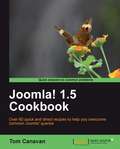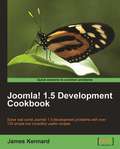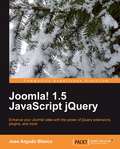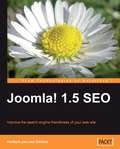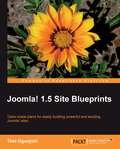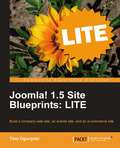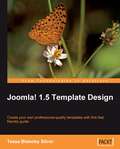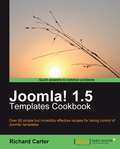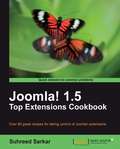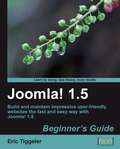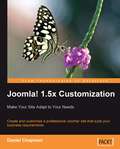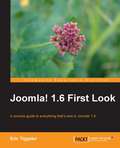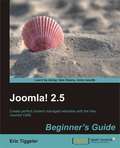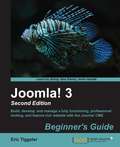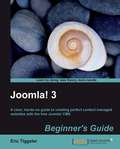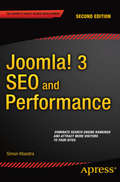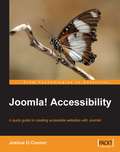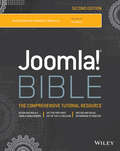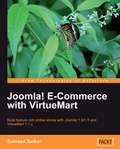- Table View
- List View
Joomla! 1.5 Content Administration
by Tracey PorstThis book is very easy and straightforward to follow, and takes a hands-on approach, using practical examples to illustrate techniques and explain concepts using a fictitious company called "The Party People" to help you master the content administration of your web site. With each task outlined, simple explanations are offered on similar subject areas and links to further information are provided. If you are someone who wants to quickly and easily manage content and users for a Joomla! web site, this book is ideal for you. You could be a content editor, proofreader, graphic artist, feature editor, or anyone else concerned with managing content on a Joomla! installation. If you can browse the Web and use a wordprocessing software package, this book will help you develop the skills to efficiently manage your web site and gain a solid understanding of the Joomla! content management system.
Joomla! 1.5 Cookbook
by Tom CanavanThis is a fast paced cookbook, with practical recipes providing tips and tricks to the most common problems and scenarios faced by Joomla! site owners. It also covers brand new concepts and scenarios of Joomla! 1.6.If you are a Joomla! site owner and have some problems that you want to get rid of quickly; or you just want to get particular things working or improved, this is the book for you. HTML, CSS, or programming knowledge not required.
Joomla! 1.5 Development Cookbook
by James KennardThis book contains recipes which define common problems and provide suggested solutions. This is not a book to read from cover-to-cover, it is hands-on solutions book that takes a practical approach to recipes - providing code samples that can easily be extracted and modified to suit the needs of the reader. Each recipe is presented as a separate entity and prior reading of other recipes is not required. Chapters provide categorization of recipes and give an introduction to the subject area with reference to the recipes contained within. This book is for PHP developers who have experience of developing for Joomla! It does not introduce developing extensions for Joomla!, it is assumed that the reader has prior knowledge of the subject and is looking for a quick guide to solve common problems quickly which commonly occur when developing for Joomla! It does not matter if you are an accomplished Joomla! developer or just starting out. For each scenario that this book addresses, there is an introductory explanation of the problem and an easy to implement solution. For the more accomplished developers recipes also include a discussion of the solution explaining how it works and how it can be further enhanced or customized.
Joomla! 1.5 Development Cookbook: LITE
by James KennardThis book is in Packt's Cookbook series. A Packt Cookbook contains recipes for solutions to the most important problems you face when working with a topic. Inside the Cookbook you will find: A straightforward and easy to follow format, A selection of the most important tasks and problems, Carefully organized instructions for solving the problem efficiently, Clear explanations of what you did, Details for applying the solution to other situations.This book is for PHP developers who have spent time attempting to extend or customize Joomla with PHP code. This book has been designed with specific Joomla! development problems in mind, and it is expected that you are comfortable using PHP code to extend and customize Joomla!
Joomla! 1.5 JavaScript jQuery
by Jose Argudo BlancoThis book is a tutorial with step-by-step instructions, packed with practical code examples, images, advice, and ideas. If you are a PHP developer who is working with Joomla!, this book is for you. It is also aimed at web designers who want to add JavaScript elements, using jQuery, to their Joomla! sites, themes, modules, and other extensions. A basic knowledge of web development and Joomal! is required. Some knowledge of JavaScript would certainly be a bonus. No knowledge of jQuery is required.
Joomla! 1.5 Multimedia
by Allan WalkerThis book is a Joomla! tutorial packed with features that you can apply to enhance your Joomla! web site. It contains step-by-step instructions for Joomla! users to build rich multimedia web sites using Joomla!. It shows you how to manually implement features into your site, as well as utilize Extensions and more automated methods. A tutorial approach means you can follow this book chapter by chapter or just dip into the topics you find of interest. This book is aimed at Joomla! administrators and site developers who want to add media-rich content elements and interactive features to their site. All you need is to have a basic knowledge of the Joomla! platform and want to develop your site with rich media content. This book is a must-read for Joomla! users wanting to collaborate with external resources such as YouTube, Twitter, Google, and Flickr (amongst others).
Joomla! 1.5 SEO
by Herbert-Jan van DintherThis is a practical, hands-on book that will lead you through the process of search engine optimization of your Joomla!-based web site. It provides clear instructions and detailed screenshots, so you can see exactly what to do at each step in the SEO process. Once you have finished reading the book and gone through the detailed plans from each chapter, you will have the knowledge to improve the rankings and visitor numbers of almost any Joomla!-based web site. This book is written for anyone using Joomla! ranging from owners of business sites to web site developers and personal web site owners. Any Joomla! web site owner who wants to sell products or services, or send out a message to the world will find that getting better rankings in the search engines will help them reach their goal. Some prior knowledge of Joomla! is expected but no prior knowledge of search engine optimization is needed for this book. The reader will get a deeper level of knowledge on how to make their web site rank better and attract more visitors to their site.
Joomla! 1.5 Site Blueprints
by Timi OgunjobiThe hands-on example projects in this book are based on fictitious website development briefs, and they illustrate practical ways of applying Joomla! The book dives straight into the process of constructing the featured projects. A chapter is dedicated to each example website project. Each chapter is a separate project booklet, written independently of any other chapter. Each chapter contains a fictitious brief from which we derive the list of core and contributed extensions that we will need to implement the project. Then each chapter progresses into step-by-step instructions for building the web project, aided by the extensive use of screenshots. This book is for Joomla! developers who want to build a range of Joomla! sites, and see how to apply the many available Joomla! extensions and features in different scenarios. If you would like to try building websites as a freelancer or give your business a professional quality web presence, this is a great book to help you get started.
Joomla! 1.5 Site Blueprints: LITE
by Timi OgunjobiEach chapter is dedicated to a hands-on example project, which are based on fictitious web site development briefs that illustrate practical ways of applying Joomla!. Each chapter contains step-by-step instructions for building the web project, aided by the extensive use of screenshots. When you have completed each project, you will have the knowledge and confidence to apply the techniques you have learned to create your own custom web application. This book is for anybody who wants to build Joomla! sites, and see how to apply the many available Joomla! plugins and features in different scenarios. If you develop Joomla! sites professionally, or would like to try building web sites as a freelancer, this is a great book to help you get started.
Joomla! 1.5 Template Design
by Tessa Blakeley SilverThis book covers the "how-tos" of creating templates for Joomla! 1.5. There is also advice about what works and what to consider when working with your Joomla! 1.5 template. Because this title is about Joomla! 1.5 templates and not about CSS or semantic XHTML, an understanding of established and current XHTML and CSS techniques for achieving compliant, semantic, and accessible designs is assumed. However, quality references and links are always given so the reader can learn more about any specific CSS or XHTML technique discussed if they are unfamiliar with it.This book is aimed at web designers who want to create their own unique templates for Joomla! 1.5. Readers should have a basic knowledge of Joomla! 1.5 (Building Websites with Joomla! 1.5 by Hagen Graf from Packt Publishing will help you with this) and also basic knowledge of table-less CSS and XHTML techniques, as well as using Dreamweaver or other text/code editors for coding purposes.
Joomla! 1.5 Templates Cookbook
by Richard CarterJoomla! 1.5 Templates Cookbook contains step-by-step instructions for Joomla! users to customize their Joomla! templates. The book is designed so that you can refer to it chapter by chapter, or you can look at the list of recipes and read those that interest you in no particular order. This book is written for Joomla! developers who want to improve the look and feel of their Joomla! sites. Readers are expected to have knowledge of CSS and (X)HTML. Although it will be helpful, no prior knowledge of Joomla! theming is expected.
Joomla! 1.5 Top Extensions Cookbook
by Suhreed SarkarIt is a cookbook which means it contains step-by-step instructions to use joomla extensions to achieve the optimal site. It shows you how to perform specific tasks in Joomla! using the popular extensions available in Joomla! extensions directory. It will also help you choose right extension for performing a specific task in Joomla! If you want to build a basic Joomla! site and are looking for information on the use of Joomla! extensions and their customization, this book is for you. Prior knowledge of using extensions is not expected but basic knowledge of setting up a Joomla! site will be required. Knowledge of PHP and database skills will be helpful but not essential.
Joomla! 1.5: Beginner's Guide
by Eric TiggelerWritten with a fast-paced but friendly and engaging approach, this Packt Beginner's guide is designed to be placed alongside the computer as your guide and mentor to meet real-world web building challenges. Step-by-step tutorials are bolstered by explanations of the reasoning behind what you are doing. You will quickly pick up the necessary skills, tips, and tricks for building a successful Joomla! web site with practical examples that help you to learn by experiment and play. If you want to build and maintain your own web site, the Joomla! Beginner's Guide is perfect for you. It helps you build on the skills and knowledge you may already have on creating web sites--but even if you're new to this subject, you won't have any difficulty understanding the clear and friendly instructions and explanations. You learn how to build and maintain web sites without having to dive deep into HTML and CSS.
Joomla! 1.5x Customization: Make Your Site Adapt to Your Needs
by Daniel ChapmanFilled with plenty of examples and careful explanations, this step-by-step guide teaches you to build a subscription-based business site with Joomla!. This site will evolve chapter by chapter as you apply the techniques and theory that you are learning to it. You will start by looking at the environment in which you develop, setting yourself up with the right tools to develop a professional site as effectively and efficiently as possible. Then you will move on to setting the purpose of our site, and why it is important to have a clear purpose and goals for your site before you ever even install Joomla!. You will begin to look through choosing, installing and customizing extensions, and proceed to work on your sample subscription site as a practical example of the information covered in each chapter. Finally you will look at how to market and monetize your site to ensure the maximum success for your site. This book is written for people with basic knowledge of Joomla! who want to expand their skills and move from simply assembling extensions and installing a template to truly customizing their own site. Readers are expected to have functional knowledge of Joomla! and a very basic understanding of terms such as FTP, PHP, HTML, CSS, JavaScript, even if they have no real knowledge of the workings behind these terms. This book does not cover topics such as installing Joomla! and extensions, or creating content. The ideal reader is one who wishes to build a successful business web site using Joomla! and is interested in making as well as saving money by applying professional tools and techniques to the development, monetization, and marketing of their site. Non-business focussed site owners can still benefit greatly from the book, however, if they wish to add a level of professionalism to their work.
Joomla! 1.6 First Look
by Eric TiggelerThis book looks at the main functional areas of Joomla! that have significant new features. All features are explained with the help of illustrative screenshots and step-by-step instructions on how to use them.This book is for existing Joomla! users, developers, and designers who want to know about everything that's new in Joomla! 1.6.
Joomla! 2.5 Beginner’s Guide
by Eric TiggelerWritten with a fast-paced but friendly and engaging approach, this Packt Beginner's guide is designed to be placed alongside the computer as your guide and mentor. Step-by-step tutorials are bolstered by explanations of the reasoning behind what you are doing. You will quickly pick up the necessary skills, tips, and tricks for building a successful Joomla! website. This book is written for beginners to website design. By the end of the book you will have built a complete custom content managed website, and be ready to build any kind of website.
Joomla! 3 Beginner's Guide Second Edition
by Eric TiggelerAn easy to use, step-by-step guide to creating professional, mobile-friendly websites with the free Joomla CMS. The Joomla! 3 Beginner's Guide Second Edition is the ultimate guide for web developers who wish to build upon their skills and knowledge on creating websites. Even if you're new to this subject, you won't have any difficulty understanding the clear and friendly instructions and explanations. No prior knowledge of HTML and CSS is required.
Joomla! 3 Beginner’s Guide
by Eric TiggelerWritten with a fast-paced but friendly and engaging approach, this Packt Beginner's Guide is designed to be placed alongside the computer as your guide and mentor. Step-by-step tutorials are bolstered by explanations of the reasoning behind what you are doing. You will quickly pick up the necessary skills, tips, and tricks for building a successful Joomla! website.This book is written for beginners to website design. By the end of the book you will have built a complete custom content managed website, and be ready to build any kind of website.
Joomla! 3 SEO and Performance
by Simon KloostraJoomla 3 SEO and Performance is a concise, 188-page book that helps you to build websites that dominate search engine rankings and have super-fast load times, giving your sites an increased audience. The book takes a very practical approach full of real-world examples. It does not just provide instructions, but also teaches you the logic behind what you are doing. It will make you breathe SEO while building your websites, which is the only way to success. Joomla 3 SEO and Performance starts with the Joomla core SEO possibilities. It shows how even if you are a relative newcomer to Joomla you will be able to build sites that rank high in Google without having to install complicated plugins. The remaining chapters dig much deeper, both into Joomla, and into the use of SEO plugins and extensions with a full chapter dedicated to SH404SEF, probably the best SEO extension for Joomla. In order to keep the visitors that you acquire, Joomla 3 SEO and Performance also shows you how to make your website load faster. This is achieved using Joomla core features as well as plugins. You will be stunned how easy it is to achieve massive improvements! Joomla 3 SEO & Performance: * Walks you through the Joomla SEO options, both basic and advanced * Teaches you to breathe SEO while building your websites * Teaches you how to make your websites screaming fast What you'll learn * Learn to build a solid basis for Joomla SEO. * Learn how Google likes you to build your site. * Use advanced and hidden techniques in Joomla. * How to use SEO extensions and plugins for even better optimization. * Optimize off-site SEO through Google Webmaster Tools and Analytics. * Make your site load lightning fast. Who this book is for Joomla 3 SEO and Performance is for anyone who needs more visitors for their website and wants to rank highly in search engines. The book is suitable for any Joomla enthusiast who has at least some basic knowledge in setting up a Joomla site, like creating articles, modules, and menus. SEO knowledge is not required, this is all explained. Table of Contents 1. How Search Engines Work 2. Preparing Your Joomla! Environment 3. Joomla! Global Configuration 4. Metadata 5. URL Structure 6. Header Tags 7. Optimizing Internal Links and Anchor Text 8. Optimizing Images 9. Microdata or Rich Snippets 10. Duplicate Content 11. 404 Errors and Pages 12. Robots. txt 13. Sitemap 14. Simple SEO Extensions 15. SH404SEF 16. SEO Site Audits 17. Off-Site SEO 18. Joomla Performance and Speed 19. Appendix A 20. Appendix B
Joomla! 3 Template Essentials
by Paweł FrankowskiUsing this hands-on, step-by step tutorial filled with practical examples, the readers will be able to create beautiful templates and themes for your websites that will make them stand out from others.This book is written for all of you who wish to create your own unique templates for Joomla! 3.x. This book can be used by Joomla! administrators or visual designers (with no programming experience) or those of you who are used to working with common web developer tools like HTML/CSS editors for coding purposes. You would need basic knowledge of Joomla! and some knowledge of CSS and HTML.
Joomla! 4 Masterclass: A practitioner's guide to building rich and modern websites using the brand-new features of Joomla 4
by Luca Marzo Anja de CromUnleash the full potential of the Joomla 4.x series while building powerful, responsive, and state-of-the-art websites with real-world use case scenariosKey FeaturesGet up and running with all new Joomla 4 features to deliver a rich experience with your websitesEnrich your learning journey while building websites in real time using real-world case studiesCustomize Joomla websites using templates to deliver better user experience to your clientsBook DescriptionJoomla has been the second-most used open-source content management system for years. It has always had many built-in features, but several of them are not very well-known in the market. This book brings to you all the major features of the Joomla 4.x series that'll enable you to build your own website and CMS on Joomla.The book begins by introducing you to the content management features that represent the hearth of the software and show you how to structure your website content to get the most out of it. You'll also find out how to extend your content with custom fields, go multilingual, and set up your custom workflow. As you advance, you'll learn all about the customization of the website, introducing templates, and child templates and overrides that'll allow you to make your site unique. The concluding chapters will take you through four different case studies, including an online learning system, a B&B booking system, and corporate and editorial websites to see how Joomla has been used in real life to achieve a specific goal for your clients.By the end of this book, you'll be able to confidently build modern websites on Joomla to deliver tailor-made solutions to your clients.What you will learnBuild your websites using Joomla 4's enhanced featuresExplore advanced content-handling features like scheduled publishing options, custom fields, and the workflow featureDiscover the search engine optimization features included in Joomla 4Set up your website to handle multiple languages and structure the navigation systemUnderstand the customization features provided by Joomla -- templates, overrides, and child templatesFind out how to use CLI to operate without accessing the CMS backendDesign tailor-made graphics by customizing Joomla templatesWho this book is forIf you are a CMS developer or website designer who knows how to build a website using ready-to-install software, this book is for you. Basic web design knowledge and experience will help you get the most out of this book. If you already know any of the previous versions of Joomla, this book will allow you to discover more about the newer releases. This book will also be beneficial for website holders and managers.
Joomla! Accessibility
by Joshue O ConnorThis is a practical book that contains many step-by-step examples for the reader to get their teeth into. Primarily, the book is designed to help the reader gain a deeper understanding of Joomla! and accessibility, but it can also be read as an introduction to assistive technology, disability, and the diversity of user requirements. The book also attempts to de-mystify accessibility and take it off the theoretical platform and firmly root it in the real world with tangible benefits for users of Joomla!. This book is a guide to any Joomla! user who wants to make their sites more accessible and the author does assume that you have a basic working knowledge of Joomla!. You don't need to know anything about accessibility -- the author tells you all that you need to know to make your Joomla! sites accessible to the widest audience. While some design skills and technical knowledge of HTML, CSS and PHP will be very useful you will still benefit from reading this book if you wish to understand more about assistive technology and the needs of people with disabilities. The book is distilled from years of hands on experience that the author has as a web developer and also working with people with disabilities.
Joomla! Bible (Bible #814)
by Ric ShrevesYour complete guide to the Joomla! content management system Whether you use Joomla! to power a website, intranet, or blog, you'll need a good how-to reference on this complex, but not always intuitive, content management software. Joomla! Bible, Second Edition is that book. It not only brings you up to speed on the changes and extensions that are now part of Joomla! 3.0, it thoroughly covers functions and tasks, including installation, configuration, management, advanced modules, and extended coverage of two key extensions. You'll learn how to obtain code and deploy it to a server; how to obtain, modify, and delete content; how to choose between the Joomla! Platform and the Joomla! CMS; and more. By the time you finish the Joomla! Bible, Second Edition, you'll be well prepared to build and maintain a Joomla!-based website. Walks you through obtaining the Joomla! 3.0 code and how to deploy it to a server, configure the site, create content, and manage content and user hierarchies Helps you get the most out of core modules that provide advanced functionality, including the Polls Module, the Banner Manager, Content Syndication, Newsfeed Aggregation, and others Includes hands-on tutorials and real-world practical applications Whether you're a content manager, website manager, developer, or do-it-yourselfer, make sure you keep Joomla! Bible, Second Edition on hand.
Joomla! Cash
by Tom Canavan Brandon DawsonThis book is a fast and easy read, taking the reader from the inception of an idea, to a fully working cash-generating website built on Joomla! This book is suitable for business people with a medium level of technical skill who need a good primer on how to implement a cash-generating website. Those unfamiliar with Joomla! Would benefit from reading Building Websites with Joomla! 1.5 Beta 1.
Joomla! E-Commerce with VirtueMart
by Suhreed SarkarThis is a step-by-step tutorial-style guide, which teaches you to build an e-commerce site through a complete practical example. Are you a Joomla! user who wants to build an e-commerce store? Do you have a Joomla! site and want to add e-commerce to it to sell products? Then this book is for you! The pre-requisites are simple. You should already know how to build a site with Joomla!, have a smattering of CSS/HTML and perhaps some PHP.

